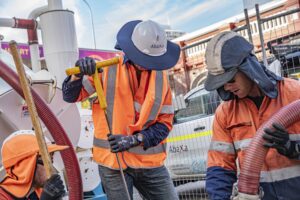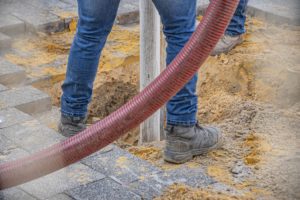Excavating around utilities can be extremely hazardous. Hand digging around utilities can cause them to become damaged, which could lead to environmental contamination, injury (including loss of life) and financial penalties.
A safer method is Vacuum Excavation – the use of high-pressure water to break apart material before being vacuumed through a tube and into a debris tank. This safe, non-destructive, ‘soft dig’ method reduces the risk of injury to personnel and eliminates the risk of damage to any surrounding structures.
Our introductory guide to all things vacuum excavation will help you decide the best method for your project – allowing you to get work done safely and at the lowest possible cost.
What is vacuum excavation used for?

In major construction projects, from commercial to residential, there will be times that underground utilities will need to be accessed, modified or upgraded.
In the past, the only way to access these was by digging down into the ground by hand or with a digger. This presents numerous hazards, as pipes carrying water or gas could be damaged, leading to injury, work stoppages and considerable costs to the liable party.
Vacuum excavation allows you to gain access to these utilities with the minimum amount of hassle – saving time, money and potentially lives.
How does vacuum excavation work?

Vacuum excavation, also known as hydro excavation, is a ‘soft dig’ method of removing soil in comparison to a ‘hard dig’, which would involve the use of a shovel or digger. Hard digs always run the risk of damaging utilities and causing utility strikes, which is why vacuum excavation is becoming so popular.
A small hole is dug using the high-pressure water lance and two tubes are placed inside the hole. One pumps high-pressure water to break up the soil, but not hard enough to damage any man-made structures. Another tube vacuums the soil into a debris tank for later disposal. Vacuum excavation units come in a range of sizes from dedicated truck units for large excavations to small trailer units.
The benefits of vacuum excavation vs. hand digging
- High precision – less material is disrupted compared to hand digging and, when work is finished, less restoration is needed.
- Save money – hydro excavation uses less manpower when compared to conventional digging.
- Work clean – dirt is stored in the debris tank keeping the area clean, which benefits work site health and safety and disruption to the public.
Abaxa, with 30 years in the sub-surface detection and utility industry, understands the value of vacuum excavation and how it can make worksites safer and more efficient.
If you are in the market for vacuum excavation in Perth, contact us online or on 1300 369 642. Our team of expert contractors are ready to answer any questions you have and help provide the solutions your project needs.







